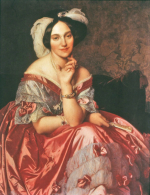Rothschild artists
"Charlotte draws beautifully - in the summer she takes sketches of sea and land and sky; in the winter she draws from casts and is going to copy some of the great pictures in the Louvre" so Charlotte, Baroness Lionel de Rothschild (1819-1884) wrote of her cousin and namesake Charlotte, Baroness Nathaniel de Rothschild (1825-1899) in 1861. Her delicate talent and great sensitivity earned her a place in Benezit's Dictionnaire des Peintres. She exhibited in the Paris Salon from 1864 and in London from 1879, many of her works were etched and she went on to co-found the French Society of Watercolourists.
Charlotte was not alone among the Rothschild women in taking a traditional accomplishment for young ladies to a high level of proficiency. Charlotte, Baroness Anselm (1807-1859), enjoyed painting enough to set the scene for a charming oil of herself and family in her studio. To this day sketches and paintings survive in considerable numbers by, among others, Charlotte, Nathan Mayer's daughter, Aline (1867-1909), Annie, (1844-1926), Evelina (1839-1866) and Emma, Lady Rothschild (1844-1935).
In the modern era, Nica de Koenigswarter, née Rothschild (1913-1988), ‘The Jazz Baroness’ painted abstract pictures, and her daughter Kari is also an artist. In the late 1960s, Jacqueline Piatigorsky (née de Rothschild) (1911-2012) discovered sculpture. Taking lessons from the Californian sculptor Anthony Amato, she developed a soft, sinuous style and a love of marble and alabaster. Beatrice Carracciolo, Baronne Eric de Rothschild is a renowned abstract artist.
Rothschild art collections
In the 19th century, members of the Rothschild family shared many collecting interests and competed with one another in their acquisitions; family members bought whole collections of paintings as they came on the market, and the collections they assembled included some of the most famous masterpieces from all the major European schools of painting from the modern period.
The wealth amassed by the family enabled them to collect the finest works to grace their splendid houses. With his purchase of The Milkmaid by the French 18th century artist Jean-Baptiste Greuze, Baron James de Rothschild (1792-1868) set himself on a course of collecting which was to grow with his wealth, fuelled not only by a desire to show himself the equal in taste and possessions of any of the French aristocracy but by a genuine interest. It was for the artists of 18th century France that the Rothschilds, from their bases in London, Paris, Vienna, Frankfurt and Naples clamoured. Add to this the Flemish and Dutch old masters of the 17th century and, later, the 18th century English portraitists like Gainsborough and Romney. Many of the great Rothschild collections can now be found in museums and galleries across the world.
Drawings & engravings
Edmond de Rothschild (1845-1934) began to collect engravings at the early age of nine. He studied them with such passion, that even when he was nearly blind he could describe in detail any one of them. During his lifetime he collected 40,000 engravings and 6,000 drawings. He acquired all Durer's engravings, and included in his collection works by lesser known masters such as Schongauer and Israel van Meckenem. In collecting engravings, Edmond not only broke with the family tradition of collecting paintings, but he perceived their artistic importance before they were considered valuable. At his death at the age of 89 in 1936, Edmond bequeathed his collection to the Louvre, having come to be recognised as a specialist with his election to the Académie des Beaux Arts. Edmond's niece, (Charlotte) Beatrice de Rothschils, Baroness Ephrussi (1864-1934), loved pastels and drawings from the 18th century, and put together a rare collection of preparatory studies and fantastic subjects in pen and ink and pencil by Fragonard. Many of these were on scraps of paper which she arranged in albums.





















